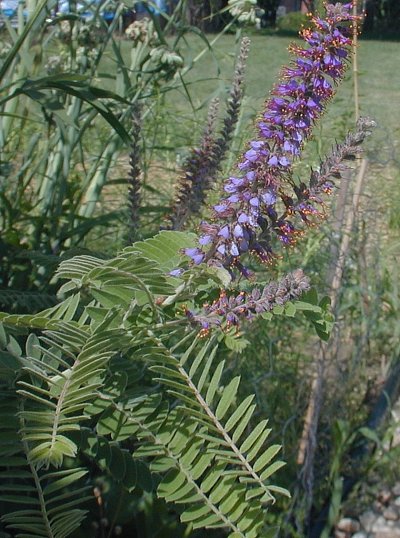Description: This perennial plant is 1-3' tall, producing occasional side branches. Leadplant is usually semi-erect; in partially shaded situations, it will sprawl along the ground in the direction of greater lighter. With age, it becomes increasing woody, assuming that growth and development are not disrupted by occasional fires or browsing from animals. The young stems are light green and covered with white hairs. The compound leaves are whitish to greyish green, depending on the intensity of sunlight reaching the plant. Sometimes fine hairs cover the plant to the extent that it appears to be heavily dusted with white lead, hence its name. The compound leaves are bipinnate, 4-12" long, and may have up to 50 small leaflets, each about ½" long and ¼" wide. The small flowers occur along pubescent spikes, about 2-6" long, at the ends of major branches. These flowers range in color from light to dark purple. Each flower has a single upper petal, which is tubular at first, but later unfolds horizontally to protect the reproductive parts. There are also 8 exerted reddish stamens with bright yellow anthers that are quite conspicuous. There is little or no floral scent. The blooming period occurs from early to mid-summer and lasts about 3 weeks. The central root occasionally branches, and can extend 15 ft. or more into the soil.

Cultivation:
The
preference is full sun and average to dry soil. Leadplant is not
particular about soil type, and it will flourish in loamy, sandy,
gravelly, or clay soil. This plant adds nitrogen to the soil. Partial
sun is
tolerated, but it will flower less abundantly and have a tendency to
sprawl. Leadplant is easy to grow, but slow to develop – flowers may
not appear for at least 3 years. A wire fence or cage may be necessary
to protect young plants from rabbits and other herbivores.
Range & Habitat:
The native Leadplant occurs primarily in the northern two-thirds of
Illinois,
where it is occasional. In southern Illinois, this plant is uncommon or
absent (see Distribution
Map). Habitats include mesic to dry black soil prairies, sand
prairies, gravel prairies, hill prairies, limestone glades, and Black
Oak savannas. The presence of Leadplant is a sign of high quality
habitat. Because of its deep roots, recovery from fire is very good.

Faunal
Associations:
The flowers of Leadplant (Amorpha canescens) attract long-tongued bees, short-tongued bees,
and wasps primarily. Among the bees are such visitors as bumblebees,
Leaf-Cutting bees (Megachile spp.), Green Metallic bees, and Plasterer
bees (Colletes spp.); the Andrenid bee, Andrena quintilis,
is an oligolege of Leadplant. The caterpillars of Colias
cesonia (Dogface Sulphur) eat the foliage occasionally, but
this butterfly often fails to overwinter successfully in Illinois.
Other insects that feed on the foliage, flowers, seeds, and other parts of Leadplant include
grasshoppers (Melanoplus spp. & others), broad-headed bugs (Alydus spp.), the plant bugs Lopidea instabilis and Plagiognathus amorphae, leaf beetles (Pachybrachis spp. & others), larvae of moths (Catocala spp. & others), and the leafhopper Scaphytopius cinereus (see Insect Table for a more complete list of these species). Many of
these insects, especially grasshoppers, are an important source of food to insectivorous birds
and other animals. Mammalian herbivores, such as deer, rabbits, and
livestock, are very fond of this plant. It is high in protein and quite
palatable. This can make Leadplant difficult to establish in areas
where these animals are abundant.
Photographic Location:
Photographs were taken at the webmaster's wildflower garden in Urbana,
Illinois.
Comments:
This is a true prairie plant.